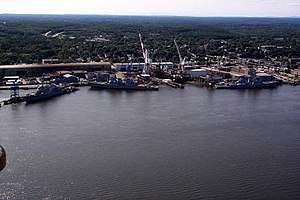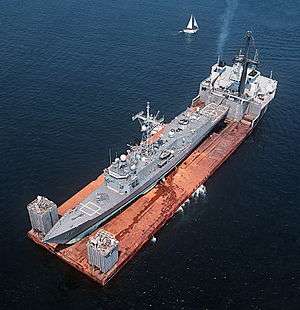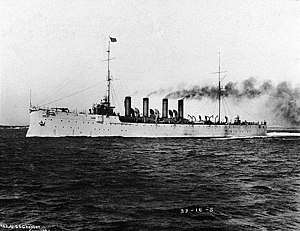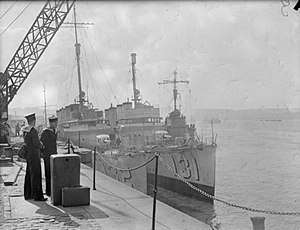Bath Iron Works
Bath Iron Works (BIW) is a major United States shipyard located on the Kennebec River in Bath, Maine, founded in 1884 as Bath Iron Works, Limited. BIW has built private, commercial, and military vessels, most of which have been ordered by the United States Navy. The shipyard has built and sometimes designed battleships, frigates, cruisers, and destroyers, including the Arleigh Burke class which are currently among the world's most advanced surface warships.
| Subsidiary | |
| Industry | Shipbuilding |
| Founded | 1884 |
| Founder | Thomas W. Hyde |
| Headquarters | , U.S. |
Number of locations | 1 |
Area served | United States |
Key people | Dirk Lesko (president) |
| Parent | General Dynamics |
| Website | gdbiw |

Since 1995, Bath Iron Works has been a subsidiary of General Dynamics, the fifth-largest defense contractor in the world as of 2008. During World War II, ships built at BIW were considered to be of superior toughness by sailors and Navy officials, giving rise to the phrase "Bath-built is best-built."[1]
History
Bath Iron Works was incorporated in 1884 by General Thomas W. Hyde, a native of Bath who served in the American Civil War. After the war, he bought a shop that made windlasses and other iron hardware for the wooden ships built in Bath's many shipyards. He expanded the business by improving its practices, entering new markets, and acquiring other local businesses. By 1882, Hyde Windlass was eyeing the new and growing business of iron shipbuilding, and it incorporated as Bath Iron Works in 1884. On February 28, 1890, BIW won its first contract for complete vessels: two iron gunboats for the Navy. One of these 190-foot (58 m) ships was the Machias, the first ship launched by the company. In 1892, the yard won its first commercial contract for the 2,500-ton steel passenger steamer City of Lowell. In the 1890s, the company built several yachts for wealthy sailors.
In 1899, Hyde was suffering from Bright's Disease and resigned from management of the shipyard, leaving his sons Edward and John in charge. The shipyard began construction of Georgia that same year, the only battleship ever built in Bath. It dominated the yard for five years until its launching in 1904, and was at times the only ship under construction. The yard faced numerous challenges because of the weight of armor and weapons. In sea trials, Georgia averaged 19.26 knots (35.67 km/h; 22.16 mph) for four hours, making her the fastest ship in her class and the fastest battleship in the United States Navy at the time. The company continued to rely on Navy contracts, which provided 86-percent of the value of new contracts between 1905 and 1917. The yard also produced fishing trawlers, freighters, and yachts throughout the first half of the century. These included Vanda, Hi-Esmaro, Aras I and Aras II, Caroline, and Corsair IV, which later served as a cruise ship before sinking off Acapulco, Mexico in 1949.[2] The shipyard was at peak production during World War II (1943–1944) and launched a destroyer every 17 days. Bath Iron Works ranked 50th among United States corporations in the value of World War II military production contracts.[3] In 1981, Falcon Transport ordered two tankers, the last commercial vessels built by BIW.

USS Samuel B. Roberts was commissioned at Bath in 1986, and it survived a mine explosion which tore a hole in its engine room and flooded two compartments. Over the next two years, BIW repaired the ship in unique fashion. The guided missile frigate was towed to the company's dry dock in Portland, Maine, and put up on blocks, where the damaged engine room was cut out of the ship. Meanwhile, workers in Bath built a 315-ton replacement, and the module was floated south to Portland, placed on the dry dock, slid into place under the frigate, jacked up, and welded into place.[4] In 1995, Bath Iron Works was bought by General Dynamics. In 2001, the company wrapped up a four-year effort to build the Land Level Transfer Facility, an enormous concrete platform for final assembly of its ships, instead of building them on a sloping way so that they could slide into the Kennebec at launch. Hulls are now moved by rail from the platform horizontally onto a moveable dry dock, which greatly reduced the work involved in building and launching the ships.[5] The 750-foot (230 m), 28,000-ton dry dock was built by China's Jiangdu Yuchai Shipbuilding Company for $27 million.[6]
In 2015, Bath Iron Works signed a contract with US Navy for new destroyers, littoral combat ships, and new landing craft. The shipyard delivered USS Rafael Peralta and USS Thomas Hudner and is working on USS Daniel Inouye and USS Carl M. Levin. The DDG block buy for Bath also includes USS John Basilone, USS Harvey C. Barnum Jr., and USS Louis H. Wilson Jr.. On March 27, Bath received a $610.4 million contract modification to build John Basilone. This ship was funded in the 2015 defense appropriations act.[7]
In 2020, 4,300 workers, all members of the International Association of Machinists and Aerospace Workers, voted to go on strike following the failure to agree to new labor contracts between the company and union members.[8]
Notable ships built

.jpg)
- Yachts
- Ranger, successful America's Cup defender
- Aras II, Presidential Yacht known as USS Williamsburg
- Corsair IV, large yacht built for J. P. Morgan Jr.
- Lightvessels
- Diamond Shoal Lightship No. 71 (LV-71)
- Nantucket Lightship 66
- Nantucket Lightship 106
- Naval ram
- Monitor
- Denver class protected cruiser
- Virginia-class battleship
- Chester-class cruiser
- Smith-class destroyers
- Paulding-class destroyers
- Cassin-class destroyers
- O'Brien-class destroyer
- Tucker-class destroyer
- Sampson-class destroyers
- Caldwell-class destroyer
- USS Manley (DD-74)[11] World War I – Guadalcanal Campaign – Operation Flintlock – Battle of Saipan – Philippines campaign (1944-45)

- Wickes-class destroyers
- USS Wickes (DD-75)[12] World War I – Destroyers for Bases Agreement
- USS Philip (DD-76)[12] World War I – Destroyers for Bases Agreement
- USS Woolsey (DD-77)[12] World War I
- USS Evans (DD-78)[12] Destroyers for Bases Agreement
- USS Buchanan (DD-131)[12] Destroyers for Bases Agreement – St. Nazaire Raid
- USS Aaron Ward (DD-132)[12] Destroyers for Bases Agreement
- USS Hale (DD-133)[12] Destroyers for Bases Agreement
- USS Crowninshield (DD-134)[12] Destroyers for Bases Agreement
- Clemson-class destroyers
.jpg)
- Thetis-class patrol boat
- USCGC Aurora (WPC-103)[14]
- USCGC Calypso (WPC-104)[14]
- USCGC Daphne (WPC-106)[15]
- USCGC Hermes (WPC-109)[15]
- USCGC Icarus (WPC-110)[15] sank U-352
- USCGC Perseus (WPC-114)[15]
- USCGC Thetis (WPC-115)[15] sank U-157
- Farragut-class destroyers (1934)
- The J-class yacht Ranger, 1936
- Mahan-class destroyers
- USS Drayton (DD-366)[19] Battle of Tassafaronga[20] Philippines campaign (1944-45)
- USS Lamson (DD-367)[19] Battle of Tassafaronga[20] - Philippines campaign (1944-45) – sunk in test Able of Operation Crossroads
- Somers-class destroyers
- USS Sampson (DD-394)[19]
- USS Davis (DD-395)[19]
- USS Jouett (DD-396)[19] Invasion of Normandy
- Sims-class destroyers
- USS Sims (DD-409)[21] Battle of the Coral Sea[22]
- USS Hughes (DD-410)[21] Battle of Midway[23] – Battle of the Santa Cruz Islands[24] – Naval Battle of Guadalcanal[25] – Philippines campaign (1944-45)
- Gleaves-class destroyers
- USS Gleaves (DD-423)[21] invasions of Sicily, Italy and Southern France
- USS Niblack (DD-424)[21] invasions of Sicily, Italy and Southern France
- USS Livermore (DD-429)[26] invasions of North Africa and Southern France
- USS Eberle (DD-430)[26] invasions of North Africa and Southern France
- USS Woolsey (DD-437)[26] invasions of North Africa, Sicily and Italy
- USS Ludlow (DD-438)[26] invasions of North Africa, Sicily, Italy and Southern France
- USS Emmons (DD-457)[27] invasions of North Africa, Normandy, Southern France and Okinawa
- USS Macomb (DD-458)[27] invasions of North Africa, Southern France and Okinawa
_running_trials_in_May_1942_(NH_49969).jpg)
- Fletcher-class destroyer
- USS Nicholas (DD-449)[28] Guadalcanal campaign – Philippines campaign (1944-45) – Korean War – Vietnam War
- USS O'Bannon (DD-450)[28] Naval Battle of Guadalcanal[29] Guadalcanal campaign – Naval Battle of Vella Lavella[30] – Philippines campaign (1944-45) – Korean War – Vietnam War
- USS Chevalier (DD-451)[28] Guadalcanal campaign – Naval Battle of Vella Lavella[30]
- USS Strong (DD-467)[28] Guadalcanal campaign
- USS Taylor (DD-468)[28] Guadalcanal campaign – Philippines campaign (1944-45) – Korean War – Vietnam War
- USS De Haven (DD-469)[28] Guadalcanal campaign
- USS Conway (DD-507)[31] Guadalcanal campaign – Philippines campaign (1944-45) – Korean War
- USS Cony (DD-508)[31] Guadalcanal campaign – Philippines campaign (1944-45) – Battle of Surigao Strait – Korean War
- USS Converse (DD-509)[31] Guadalcanal campaign – Battle of Empress Augusta Bay[32] Battle of Cape St. George[33] – Battle of the Philippine Sea[18] - Philippines campaign (1944-45)
- USS Eaton (DD-510)[31] Guadalcanal campaign – Philippines campaign (1944-45)
- USS Foote (DD-511)[31] Guadalcanal campaign – Battle of Empress Augusta Bay[32] - Philippines campaign (1944-45) – Battle of Okinawa
- USS Spence (DD-512)[31] Guadalcanal campaign – Battle of Empress Augusta Bay[32] - Battle of Cape St. George[33] - Battle of the Philippine Sea[18] - Philippines campaign (1944-45)
- USS Terry (DD-513)[31] Guadalcanal campaign – Battle of the Philippine Sea[18] - Battle of Iwo Jima
- USS Thatcher (DD-514)[31] Guadalcanal campaign – Battle of Empress Augusta Bay[32] - Battle of the Philippine Sea[18] - Philippines campaign (1944-45) – Battle of Okinawa
- USS Anthony (DD-515)[31] Guadalcanal campaign – Battle of the Philippine Sea[18] - Battle of Okinawa
- USS Wadsworth (DD-516)[31] Guadalcanal campaign – Battle of the Philippine Sea[18] - Philippines campaign (1944-45) – Battle of Okinawa
- USS Walker (DD-517)[31] Philippines campaign (1944-45) – Battle of Okinawa – Korean War – Vietnam War
- USS Abbot (DD-629)[34] Philippines campaign (1944-45)
- USS Braine (DD-630)[34] Battle of the Philippine Sea[18] - Philippines campaign (1944-45) – Battle of Okinawa
- USS Erben (DD-631)[34] Philippines campaign (1944-45) – Battle of Okinawa – Korean War
- USS Hale (DD-642)[34] Philippines campaign (1944-45) – Battle of Okinawa
- USS Sigourney (DD-643)[34] Guadalcanal campaign – Philippines campaign (1944-45) – Battle of Surigao Strait
- USS Stembel (DD-644)[34] Philippines campaign (1944-45) – Battle of Okinawa – Korean War
- USS Caperton (DD-650)[34] Battle of the Philippine Sea[18] - Philippines campaign (1944-45)
- USS Cogswell (DD-651)[34] Battle of the Philippine Sea[18] - Philippines campaign (1944-45) – Vietnam War
- USS Ingersoll (DD-652)[34] Mariana and Palau Islands Campaign – Philippines campaign (1944-45)[18] - Battle of Okinawa – Vietnam War
- USS Knapp (DD-653)[34] Battle of the Philippine Sea[18] - Philippines campaign (1944-45)
- USS Remey (DD-688)[35] Battle of Saipan – Philippines campaign (1944-45) – Battle of Surigao Strait – Battle of Okinawa
- USS Wadleigh (DD-689)[35] Battle of Saipan
- USS Norman Scott (DD-690)[35] Battle of Saipan
- USS Mertz (DD-691)[35] Philippines campaign (1944-45)
- Allen M. Sumner-class destroyers
- USS Barton (DD-722)[36] Invasion of Normandy – Philippines campaign (1944-45) – Korean War
- USS Walke (DD-723)[36] Invasion of Normandy – Philippines campaign (1944-45) – Battle of Okinawa – Korean War – Vietnam War
- USS Laffey (DD-724)[36] Invasion of Normandy – Philippines campaign (1944-45) – Battle of Okinawa – Korean War – preserved National Historic Landmark in Charleston, South Carolina
- USS O'Brien (DD-725)[36] Invasion of Normandy – Philippines campaign (1944-45) – Korean War – Vietnam War
- USS Meredith (DD-726)[36] Invasion of Normandy
- USS De Haven (DD-727)[36] Philippines campaign (1944-45) – Battle of Okinawa – Korean War
- USS Mansfield (DD-728)[36] Philippines campaign (1944-45) – Korean War – Vietnam War
- USS Lyman K. Swenson (DD-729)[36] Philippines campaign (1944-45) – Battle of Okinawa – Korean War – Vietnam War
- USS Collett (DD-730)[36] Philippines campaign (1944-45) – Korean War
- USS Maddox (DD-731)[36] Battle of Okinawa – Korean War – Gulf of Tonkin Incident – Vietnam War
- USS Hyman (DD-732)[36] Battle of Okinawa – Korean War
- USS Mannert L. Abele (DD-733)[36] Battle of Okinawa
- USS Purdy (DD-734)[36] Battle of Okinawa – Korean War
- USS Robert H. Smith (DM-23)[13] Battle of Okinawa
- USS Thomas E. Fraser (DM-24)[13] Battle of Okinawa
- USS Shannon (DM-25)[13] Battle of Okinawa
- USS Harry F. Bauer (DM-26)[13] Battle of Okinawa
- USS Adams (DM-27)[13] Battle of Okinawa
- USS Tolman (DM-28)[13] Battle of Okinawa
- USS Drexler (DD-741)[36] Battle of Okinawa
%2C_11_May_1962.jpg)
- Gearing-class destroyers
- USS Frank Knox (DD-742)[37] World War II – Korean War – Vietnam War
- USS Southerland (DD-743)[37] World War II – Korean War – Vietnam War
- USS Chevalier (DD-805)[38] Korean War
- USS Higbee (DD-806)[38] World War II – Korean War – Vietnam War – Battle of Dong Hoi
- USS Benner (DD-807)[38] World War II – Vietnam War
- USS Dennis J. Buckley (DD-808)[38] Vietnam War
- USS Agerholm (DD-826)[38] Korean War – Vietnam War
- USS Robert A. Owens (DD-827)[38]
- USS Timmerman (DD-828)[38] (Experimental ship completed with aluminum superstructure and high-horsepower engines)
- USS Myles C. Fox (DD-829)[38] Vietnam War
- USS Everett F. Larson (DD-830)[38] Vietnam War
- USS Goodrich (DD-831)[38]
- USS Hanson (DD-832)[38] Korean War – Vietnam War
- USS Herbert J. Thomas (DD-833)[38] Korean War – Vietnam War
- USS Turner (DD-834)[38]
- USS Charles P. Cecil (DD-835)[38] Vietnam War
- USS George K. MacKenzie (DD-836)[38] Korean War – Vietnam War
- USS Sarsfield (DD-837)[38] Vietnam War
- USS Ernest G. Small (DD-838)[38] Korean War
- USS Power (DD-839)[38] Vietnam War
- USS Glennon (DD-840)[38]
- USS Noa (DD-841)[38] Recovered astronaut John Glenn in Friendship 7 on 20 February 1962
- USS Fiske (DD-842)[38] Korean War – Vietnam War
- USS Warrington (DD-843)[38]
- USS Perry (DD-844)[38] Vietnam War
- USS Bausell (DD-845)[38] Korean War – Vietnam War
- USS Ozbourn (DD-846)[38] Korean War – Vietnam War
- USS Robert L. Wilson (DD-847)[38] Vietnam War
- USS Witek (DD-848)[39] (no overseas deployments – used exclusively for ASW research)
- USS Richard E. Kraus (DD-849)[39] Vietnam War
- Dealey-class destroyer escorts
_underway_in_the_early_1960s.jpg)
- Mitscher-class destroyers
- Forrest Sherman-class destroyers
- USS Forrest Sherman (DD-931)[42]
- USS John Paul Jones (DD-932)[42]
- USS Barry (DD-933)[42] Vietnam War
- USS Manley (DD-940)[42] Vietnam War
- USS Dupont (DD-941)[42]
- USS Bigelow (DD-942)[42] Vietnam War
- USS Hull (DD-945)[42] Vietnam War
- USS Edson (DD-946)[42] Vietnam War
- USS Somers (DD-947)[42] Vietnam War
- Charles F. Adams-class destroyers
- USS Charles F. Adams (DDG-2)[43]
- USS John King (DDG-3)[43]
- USS Sampson (DDG-10)[43]
- USS Sellers (DDG-11)[43]
- Farragut-class destroyers (1958)
- Leahy-class cruisers
- USS Leahy (CG-16)[45]
- USS Harry E. Yarnell (CG-17)[45]
- USS Worden (CG-18)[45] Vietnam War
- Belknap-class cruisers
- USS Belknap (CG-26)[46]
- USS Josephus Daniels (CG-27)[46]
- USS Wainwright (CG-28)[46] Vietnam War
- USS William H. Standley (CG-32)[46] Vietnam War
- USS Biddle (CG-34)[46] Vietnam War
- Garcia-class frigate
- USS Glover (FF-1098)[47]
- Brooke-class frigates
- USS Talbot (FFG-4)[48]
- USS Richard L. Page (FFG-5)[48]
- USS Julius A. Furer (FFG-6)[48]
- Oliver Hazard Perry-class frigates
- USS Oliver Hazard Perry (FFG-7)[49]
- USS McInerney (FFG-8)[49]
- USS Clark (FFG-11)[49]
- USS Samuel Eliot Morison (FFG-13)[49]
- USS Estocin (FFG-15)[49]
- USS Clifton Sprague (FFG-16)[49]
- USS Flatley (FFG-21)[49]
- USS Jack Williams (FFG-24)[49]
- USS Gallery (FFG-26)[49]
- USS Stephen W. Groves (FFG-29)[49]
- USS John L. Hall (FFG-32)[49]
- USS Aubrey Fitch (FFG-34)[49]
- USS Underwood (FFG-36)[49]
- USS Doyle (FFG-39)[49]
- USS Klakring (FFG-42)[49]
- USS Dewert (FFG-45)[49]
- USS Nicholas (FFG-47)[49]
- USS Robert G. Bradley (FFG-49)[49]
- USS Taylor (FFG-50)
- USS Hawes (FFG-53)
- USS Elrod (FFG-55)
- USS Simpson (FFG-56), launched August 31, 1984. One of four U.S. Navy ships in commission to have sunk an enemy vessel with shipboard weaponry, the others being the USS Constitution, USS Porter (DDG-78), and USS Carter Hall (LSD-50),
- USS Samuel B. Roberts (FFG-58), launched in 1984
and repaired after being punctured by a mine in 1988
- Ticonderoga-class cruisers
- USS Thomas S. Gates (CG-51)
- USS Philippine Sea (CG-58)
- USS Normandy (CG-60)
- USS Monterey (CG-61)
- USS Cowpens (CG-63)
- USS Gettysburg (CG-64)
- USS Shiloh (CG-67)
- USS Lake Erie (CG-70), 21 Feb 2008 shot down the errant USA 193 satellite with a modified SM3 missile.
- Arleigh Burke-class destroyers
- USS Arleigh Burke (DDG-51), commissioned July 4, 1991.
- USS John Paul Jones (DDG-53)
- USS Curtis Wilbur (DDG-54)
- USS John S. McCain (DDG-56)
- USS Laboon (DDG-58)
- USS Paul Hamilton (DDG-60)
- USS Fitzgerald (DDG-62)
- USS Carney (DDG-64)
- USS Gonzalez (DDG-66)
- USS The Sullivans (DDG-68)
- USS Hopper (DDG-70)
- USS Mahan (DDG-72)
- USS Decatur (DDG-73)
- USS Donald Cook (DDG-75)
- USS Higgins (DDG-76)
- USS O'Kane (DDG-77)
- USS Oscar Austin (DDG-79)
- USS Winston S. Churchill (DDG-81)
- USS Howard (DDG-83)
- USS McCampbell (DDG-85)
- USS Mason (DDG-87)
- USS Chafee (DDG-90)
- USS Momsen (DDG-92)
- USS Nitze (DDG-94)
- USS Bainbridge (DDG-96), launched in 2005
- USS Sampson (DDG-102)
- USS Sterett (DDG-104)
- USS Stockdale (DDG-106)
- USS Wayne E. Meyer (DDG-108)
- USS Jason Dunham (DDG 109)
- USS Spruance (DDG-111)
- USS Michael Murphy (DDG-112)
- USS Rafael Peralta (DDG-115)
- USS Thomas Hudner (DDG-116)
- USS Daniel Inouye (DDG-118)
- USS Carl M. Levin (DDG-120)
- USS John Basilone (DDG-122)
- USS Harvey C. Barnum Jr. (DDG-124)
- USS Louis H. Wilson Jr. (DDG-126)
- USS Patrick Gallagher (DDG-127)
- USS William Charette (DDG-130)
- Zumwalt-class destroyers
- USS Zumwalt (DDG-1000)
- USS Michael Monsoor (DDG-1001)
- USS Lyndon B. Johnson (DDG-1002)
References
- See Peniston, Sanders, Snow.
- "End Games – PORTLAND MAGAZINE". www.portlandmonthly.com.
- Peck, Merton J.; Scherer, Frederic M. (1962), The Weapons Acquisition Process: An Economic Analysis, Harvard Business School, p. 619
- "FFG 58: Repair at Bath Iron Works". navybook.com. 5 February 2013.
- GDBIW.com Archived 2007-09-28 at the Wayback Machine
- "Bath Iron Works picks Chinese firm". United Press International. 1998-09-14. Retrieved 2008-10-18.
- "Flurry of Contracts Spark US Navy Shipbuilding". Retrieved 9 August 2016.
- O'Brien, Kathleen; Overton, Penelope; Wolfe, Rob (June 22, 2020). "Bath Iron Works' largest union votes to strike". Portland Press Herald. MaineToday Media. Retrieved July 2, 2020.
- "Nevada". Dictionary of American Naval Fighting Ships. United States Navy. Archived from the original on 14 March 2004. Retrieved 12 December 2013.
- Silverstone, Paul H. U.S. Warships of World War II Doubleday & Company (1968) p.103
- Silverstone, Paul H. U.S. Warships of World War II Doubleday & Company (1968) p.276
- Fahey, James C. The Ships and Aircraft of the United States Fleet Ships and Aircraft (1939) p.17
- Silverstone, Paul H. U.S. Warships of World War II Doubleday & Company (1968) p.212
- Silverstone, Paul H. U.S. Warships of World War II Doubleday & Company (1968) p.380
- Silverstone, Paul H. U.S. Warships of World War II Doubleday & Company (1968) p.383
- Silverstone, Paul H. U.S. Warships of World War II Doubleday & Company (1968) p.114
- Oftsie, R.A., RADM USN The Campaigns of the Pacific War United States Government Printing Office (1946) p.55
- Tillman, Barrett Clash of the Carriers (2005) ISBN 0-451-21956-2 pp.301-306
- Silverstone, Paul H. U.S. Warships of World War II Doubleday & Company (1968) p.118
- Oftsie, R.A., RADM USN The Campaigns of the Pacific War United States Government Printing Office (1946) p.140
- Silverstone, Paul H. U.S. Warships of World War II Doubleday & Company (1968) p.126
- Oftsie, R.A., RADM USN The Campaigns of the Pacific War United States Government Printing Office (1946) p.54
- Oftsie, R.A., RADM USN The Campaigns of the Pacific War United States Government Printing Office (1946) p.74
- Oftsie, R.A., RADM USN The Campaigns of the Pacific War United States Government Printing Office (1946) p.122
- Oftsie, R.A., RADM USN The Campaigns of the Pacific War United States Government Printing Office (1946) p.128
- Silverstone, Paul H. U.S. Warships of World War II Doubleday & Company (1968) p.129
- Silverstone, Paul H. U.S. Warships of World War II Doubleday & Company (1968) p.132
- Silverstone, Paul H. U.S. Warships of World War II Doubleday & Company (1968) p.135
- Oftsie, R.A., RADM USN The Campaigns of the Pacific War United States Government Printing Office (1946) p.127
- Oftsie, R.A., RADM USN The Campaigns of the Pacific War United States Government Printing Office (1946) p.148
- Silverstone, Paul H. U.S. Warships of World War II Doubleday & Company (1968) p.138
- Oftsie, R.A., RADM USN The Campaigns of the Pacific War United States Government Printing Office (1946) p.153
- Oftsie, R.A., RADM USN The Campaigns of the Pacific War United States Government Printing Office (1946) p.159
- Silverstone, Paul H. U.S. Warships of World War II Doubleday & Company (1968) p.141
- Silverstone, Paul H. U.S. Warships of World War II Doubleday & Company (1968) p.143
- Silverstone, Paul H. U.S. Warships of World War II Doubleday & Company (1968) pp.146-7
- Silverstone, Paul H. U.S. Warships of World War II Doubleday & Company (1968) p.148
- Silverstone, Paul H. U.S. Warships of World War II Doubleday & Company (1968) p.150
- Silverstone, Paul H. U.S. Warships of World War II Doubleday & Company (1968) p.152
- Blackman, Raymond V. B. Jane's Fighting Ships (1970/71) p.458
- Blackman, Raymond V. B. Jane's Fighting Ships (1970/71) p.435
- Blackman, Raymond V. B. Jane's Fighting Ships (1970/71) p.439
- Blackman, Raymond V. B. Jane's Fighting Ships (1970/71) p.437
- Blackman, Raymond V. B. Jane's Fighting Ships (1970/71) p.432
- Blackman, Raymond V. B. Jane's Fighting Ships (1970/71) p.431
- Blackman, Raymond V. B. Jane's Fighting Ships (1970/71) p.429
- Blackman, Raymond V. B. Jane's Fighting Ships (1970/71) p.456
- Blackman, Raymond V. B. Jane's Fighting Ships (1970/71) p.452
- Clement, Janet Ann, LT USNR "The FFG-7 Program: A Shipbuilding Status Report" United States Naval Institute Proceedings (June 1981) p.109
Further reading
- Eskew, Garnett Laidlaw (1958). Cradle of Ships. New York: Putnam. ASIN B0007E5VY4. (First general history of BIW.)
- Peniston, Bradley (2006). No Higher Honor: Saving the USS Samuel B. Roberts in the Persian Gulf. Annapolis: Naval Institute Press. ISBN 1-59114-661-5. Archived from the original on 2006-07-12. Retrieved 2006-03-08. (Describes the construction of a Perry-class guided missile frigate, the training of its precommissioning crew at BIW, and the complex repair job that returned it to duty.)
- Sanders, Michael S. (1999). The Yard: Building a Destroyer at the Bath Iron Works. New York: HarperCollins. ISBN 0-06-019246-1. (Describes the construction of USS Donald Cook (DDG-75) at BIW.)
- Snow, Ralph L. (1987). Bath Iron Works: The First Hundred Years. Bath, Maine: Maine Maritime Museum. ISBN 0-9619449-0-0. (The definitive work on BIW from 1884 to 1987.)
- Toppan, Andrew (2002). Bath Iron Works (Images of America: Maine). South Carolina: Arcadia Publishing. ISBN 0-7385-1059-9. (Historic and contemporary photos of BIW.)
External links
| Wikimedia Commons has media related to Bath Iron Works. |